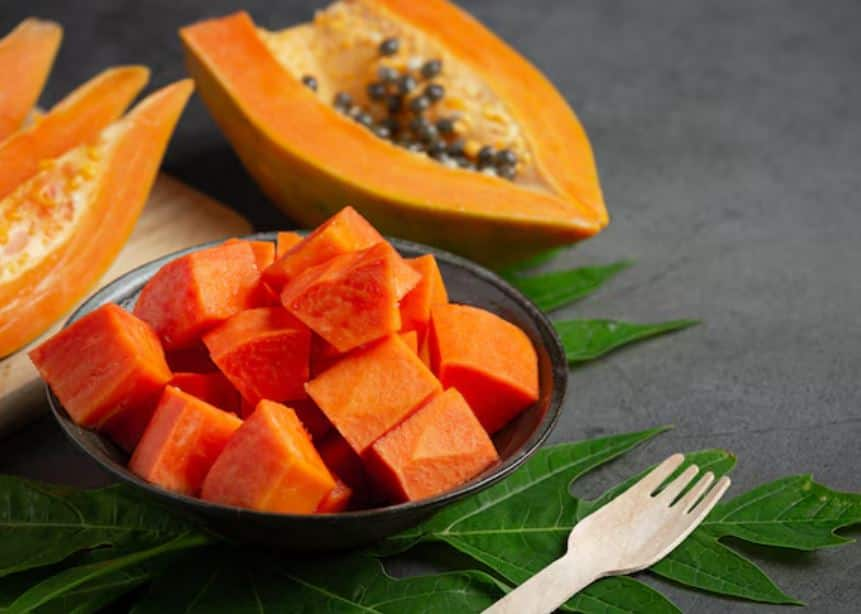Papaya is one of summer’s most loved fruits—refreshing, sweet, and loaded with nutrients like vitamin C, enzymes, and antioxidants. But as the demand for this tropical fruit rises during the hotter months, so does the risk of buying artificially ripened or fake papayas. These chemically-ripened fruits not only lack nutritional value but can also harm your health in the long run. That’s why it’s crucial to know how to identify real versus fake papayas, especially when you’re trying to keep your family safe and healthy.
Here’s a detailed guide on spotting fake papayas from the real ones using simple methods, straight from your kitchen.
1. Check the Skin Color and Texture
A naturally ripened papaya has a consistent yellow-orange hue with a smooth texture. Look for blemishes or patches of green, which are normal. On the other hand, chemically ripened papayas may have an overly shiny appearance, uneven coloring, and sudden color patches—often bright yellow mixed with deep green. These signs indicate the use of artificial ripening agents like calcium carbide.
Quick Tip: Real papayas usually show a gradual color transition from green to yellow. If the change looks abrupt or unnatural, be cautious.
2. Sniff the Aroma
The smell test can be your biggest clue. Ripe papayas have a mildly sweet, fruity aroma that becomes stronger near the stem area. Fake or chemically ripened ones often lack this natural fragrance or may have a sharp, artificial smell due to the chemicals used.
What to do: Smell the papaya near the stem. If it has no scent or smells synthetic, it may not be naturally ripened.
3. Feel the Firmness
Naturally ripened papayas feel soft but not mushy. If the fruit is overly soft, especially in some areas while being hard in others, it’s a red flag. Artificial ripening accelerates the outside while the inside may remain raw.
Touch Test: Press lightly on different parts. Real papayas give gentle resistance throughout. Inconsistent firmness could signal chemical tampering.
4. Cut and Observe the Inside
When you cut a real papaya, the flesh is usually deep orange or reddish, evenly ripe, and filled with black seeds. In contrast, fake ones may have pale or patchy interiors, an unpleasant smell, or immature seeds.
Check This: If the inside looks unusually dry, white, or has an off-putting smell, avoid eating it.
5. Float Test (Bonus Tip)
Fill a bowl with water and drop the papaya in. Natural papayas are denser and tend to sink slowly. Papayas that float might be artificially ripened or pumped with chemicals to enhance their weight or color.
6. Know Where You’re Buying From
Buying from trusted vendors, organic markets, or your local farmer’s market is a great way to reduce the chances of getting fake fruits. Always choose seasonal and locally sourced papayas over off-season or imported ones.
Why Are Fake Papayas Harmful?
Artificial ripening agents like calcium carbide release acetylene gas, which mimics the natural ripening process but is highly toxic. Prolonged exposure can lead to serious health issues, including headaches, mood disturbances, skin problems, dizziness, and even carcinogenic effects over time.
How to Safely Ripen Papayas at Home
1. Use the natural method: Place green papayas in a brown paper bag with a ripe banana or apple. These fruits release ethylene gas, which naturally ripens the papaya over a few days.
2. Keep at room temperature: Avoid refrigerating unripe papayas. Allow them to ripen naturally on the counter.
While papaya is a fantastic addition to your summer diet—hydrating, digestion-friendly, and rich in nutrients—it’s equally important to ensure you’re eating the real deal. With rising instances of food adulteration and chemically-treated fruits in the market, these simple home tests can make a huge difference in safeguarding your health.
So the next time you buy papaya, use your senses—look, touch, smell, and even test it in water—to identify if it’s real or fake. Your summer wellness begins with smarter, safer food choices!
(This article is meant for informational purposes only and must not be considered a substitute for advice provided by qualified medical professionals.)
